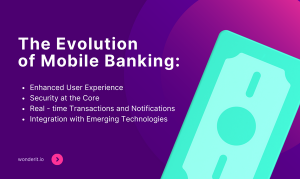Explore the latest trends and statistics surrounding mobile banking and finance devices. Learn how these cutting-edge technologies are revolutionising the financial industry.
In the quickening world of technology today, mobile banking and finance have become integral parts of our daily lives. Gone are the days when people had to visit physical banks or ATMs to manage their finances. Thanks to software development, mobile banking and finance have undergone a remarkable transformation, offering users unprecedented convenience, security, and accessibility. In this article, we will explore how software development is changing the landscape of mobile banking and finance devices, and how these advancements are reshaping the way we manage our money.
The Rise of Mobile Banking and Finance Devices
Mobile banking and finance devices encompass a wide range of technologies and applications that empower individuals and businesses to manage their finances seamlessly. These devices include smartphones, tablets, wearables, and specialised mobile banking apps. The convenience and accessibility they provide have led to a significant surge in their adoption.
History of Mobile Banking
Before the introduction and proliferation of mobile web services in 1999, mobile banking primarily relied on text-based communication and was commonly referred to as SMS banking. At that time, SMS (Short Message Service) was the predominant means of sending messages as mobile phone usage expanded in the late 1990s, and SMS banking adopted this communication format. SMS banking and mobile web services were the predominant forms of mobile banking up until 2010.
The emergence of Wireless Application Protocol (WAP) opened up new avenues for accessing the internet on mobile phones, presenting fresh opportunities for banks as well. The inaugural WAP banking services made their debut in Norway in 1999 and swiftly extended to other nations. As smartphones featuring iOS and Android operating systems gained prominence, mobile banking applications underwent a transformative evolution.
Clients were now able to download banking applications onto their smartphones, equipped with more sophisticated interfaces and enhanced transaction capabilities. To this day, numerous financial institutions leverage both SMS and mobile applications to keep their clients informed about account activities, issue alerts related to potential fraud, provide updates, and ensure the smooth maintenance of service provision.
The Evolution of Mobile Banking and Finance Devices
Mobile banking and finance devices have come a long way from their initial inception. Today, they are indispensable tools that empower users to manage their finances anytime, anywhere. According to a report by Juniper Research, the global mobile banking user base is projected to reach a staggering 3.6 billion by 2024. This rapid adoption highlights the increasing reliance on mobile devices for financial activities.

Enhanced User Experience
One of the key ways software development is changing the game in mobile banking and finance is by enhancing the user experience (UX). Research from UserZoom reveals that 88% of users are less likely to return to a website or app after a poor user experience. Hence, creating an intuitive and user-friendly interface has never been more critical.
Responsive design is now a standard practice, ensuring seamless accessibility across various devices, including smartphones, tablets, and desktops. User-centric design principles are applied to craft interfaces that are not only aesthetically pleasing but also highly functional.
Security at the Core
Security remains a paramount concern in the financial sector, and software development plays a pivotal role in fortifying mobile banking and finance apps. According to a survey by Ipsos, 68% of consumers are concerned about the security of their financial data when using mobile banking services. To address these concerns, software developers employ robust encryption techniques such as SSL and TLS to protect data during transmission.
Furthermore, biometric authentication methods like fingerprint recognition and facial recognition have gained widespread adoption, adding an extra layer of security. Continuous updates and patches to address emerging threats are vital in maintaining the trust of users.
Real-time Transactions and Notifications
The power of real-time transactions and notifications cannot be overstated. A study by McKinsey & Company found that 48% of mobile banking users prefer real-time alerts about their account balances and transactions. Software development has made this preference a reality.
Users can now conduct transactions, transfer funds, and receive instantaneous updates on their account activities. Push notifications and alerts keep users informed about account balances, potential overdrafts, and suspicious transactions. This real-time functionality puts users firmly in control of their finances, contributing to better financial management.
Integration with Emerging Technologies
Software development continually embraces emerging technologies to enhance mobile banking and finance services:
Artificial Intelligence (AI): AI-powered chatbots and virtual assistants are revolutionising customer service. They can handle inquiries, facilitate transactions, and even provide financial advice. A Capgemini report states that 83% of banks believe AI will enable them to achieve better customer experiences.
Blockchain Technology: Blockchain’s potential in mobile banking is significant. It can offer secure and transparent transaction records, reducing fraud and increasing trust. According to Deloitte, 53% of financial services companies believe blockchain will greatly impact their business.
Internet of Things (IoT): IoT devices, such as smartwatches and home assistants, are becoming integrated with mobile banking apps, offering users seamless access and control over their finances.
Augmented Reality (AR) and Virtual Reality (VR): While in the experimental phase, AR and VR hold promise for immersive financial experiences. This technology can be used for virtual branch visits and personalised financial simulations.
Statistics on Mobile Banking and Finance Device Usage
To gain a better understanding of the growing importance of mobile banking and finance devices, let’s take a look at some key statistics:
- Mobile Banking App Usage: As anticipated, the upward trajectory of app utilisation is clearly discernible within the banking sector, which ranks among the most advanced industries. This trend is characterised by a substantial increase of 16% in the installation of financial apps and a 45% surge in their usage from 2019 to 2020 (Science Direct).
- Mobile Payment Transactions: The adoption of mobile devices for payments is on the rise. The prevalence of mobile payments, which involve conducting transactions using wireless devices such as smartphones or tablets, is experiencing global growth. Based on findings from a study released by Allied Market Research, the global mobile payment market was valued at $1.48 trillion in 2019, and it is projected to reach a substantial $12.06 trillion by 2027 (U.S. Bank).
- Smartphone Ownership: Globally, smartphone ownership is at an all-time high. 5.44 billion of the world’s population owns a smartphone, providing a massive user base for mobile banking and finance applications. This widespread adoption is a driving force behind the growth of mobile banking (DataProt).
- Wearable Technology: Wearable devices, such as smartwatches and fitness trackers, are increasingly integrated with financial apps. Most wearable device owners use them for tasks like checking account balances and making contactless payments, making them a valuable addition to the mobile finance ecosystem (M2P).
- Mobile Security: With the rise of mobile finance, security is a paramount concern. The users cite security as the most crucial factor when choosing a mobile banking app. This emphasis on security has led to continuous advancements in encryption and biometric authentication methods (Research Gate).
Trends in Mobile Banking and Finance Devices
As technology continues to evolve, several notable trends are shaping the future of mobile banking and finance devices:
Contactless Payments: Contactless payments, enabled by NFC technology, are gaining traction. With a simple tap, users can complete transactions quickly and securely, reducing the need for physical cash and cards.
Personal Financial Management: Mobile apps are increasingly offering features for personal financial management, including budgeting, expense tracking, and investment management. These tools empower users to take control of their finances.
Blockchain and Cryptocurrency: The integration of blockchain technology and cryptocurrencies into mobile finance apps is opening up new possibilities for secure and decentralised financial services.
AI-Powered Customer Support: AI-driven chatbots and virtual assistants are becoming commonplace in mobile banking apps, providing users with instant assistance and personalised recommendations.
Biometric Authentication: Biometric authentication methods, such as fingerprint recognition and facial recognition, are enhancing security and simplifying the login process for users.
The Future of Mobile Banking and Finance Devices
Looking ahead, the future of mobile banking and finance devices appears promising. As technology continues to advance, we can expect even more innovative features and increased convenience for users. From biometrics to blockchain, the financial industry is embracing these devices to deliver a superior banking experience. Here are some exciting possibilities:
Enhanced Security – Expect even more robust security features, including advanced biometrics and multi-factor authentication, to safeguard financial transactions.
Expanded Services – Mobile devices will likely offer a broader range of financial services, from investment management to insurance purchasing.
Seamless Integration – The integration of mobile banking and finance devices with other smart devices, such as smart cars and homes, will provide users with a seamless and interconnected financial ecosystem.
Global Accessibility – Mobile banking and finance devices will continue to bridge the gap between the banked and unbanked populations, providing financial services to previously underserved regions.
Innovations in Cryptocurrency – Mobile devices will play a pivotal role in the mainstream adoption of cryptocurrencies, with more accessible and user-friendly crypto solutions.
Conclusion
In conclusion, mobile banking and finance devices have become integral to the financial industry’s evolution. Their widespread adoption, coupled with the latest trends and statistics, demonstrates their importance in reshaping how we manage our finances. As consumers increasingly rely on mobile devices for banking and financial transactions, it’s imperative for financial institutions and businesses to stay at the forefront of this digital revolution. Embracing mobile banking and finance devices is not just a trend—it’s the future of finance.
If you’re interested in learning more about how our software company can help you leverage the power of mobile banking and finance devices, feel free to reach out to us. We’re here to assist you in staying ahead in the ever-evolving world of financial technology.


Recent Comments